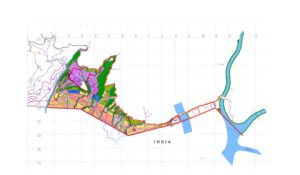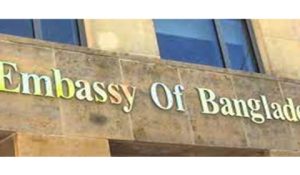Name: Detail Sub Soil investigation for the proposed bridge over Yuderi on Trashigang-Phongmey GC road
name of the Client: Bridge Division, Department of Roads, MOWHS
Project Description: Detail subsoil investigation of a bridge over GC road.
Scope of work: The detailed descriptions of the scope of works to be undertaken by the consultants in carrying of the works are as given below:
Determination of borehole locations
The tentative borehole locations are shown in the Drawing attached. However, the Consultant shall decide the exact borehole location and depth for collection of sub-soil sample in consultation with the client. Total of three bore holes shall be done at right bank of Yuderi. The depth of the boreholes shall not be less than 15 meter from the surface unless confirmed refusal is encountered prior to achieving the prescribed depth. The engineering properties of the sub-soil strata at the location shall be worked out as detailed in the following-
Sub-Soil Exploration and Determination of Engineering Properties of Soil
The boring for collection of sample shall be done at the proposed location of abutments as per approximate span arrangement fixed. The sub-soil investigation shall broadly consist of two stages, preliminary Investigation and Detailed investigation. In general the investigation procedure and collection of data shall follow the guidelines provided in IRC 78: 2000. The scope of sub-soil investigation in brief are as below:
(A) Preliminary Investigation
(i) Preliminary investigation shall include the study of existing geological information, previous site reports, geological maps etc., and surface geological examination. These will help to narrow down the number of sites under consideration and also to locate the most desirable location for detailed sub-surface investigation.
(B) Detailed Investigation
(i) Based on data obtained after preliminary investigations, the bridge site, the type of structure with span arrangement and the location and type of foundations, program of detailed investigations, etc., shall be tentatively decided. Thereafter the scope of detailed investigation including the extent of exploration, type of tests, number of tests etc., shall be decided in close liaison with the client. (ii) The exploration shall cover the entire length of the bridge and also at either end at a distance of zone of influence i.e. about twice the depth below bed of the last main foundation to assess the effect of the approach embankment on the end foundations. Generally the subsurface investigations should extend to a depth below the anticipated Yuderi. Foundation level equal to about one and a half times the width of the foundation. However, where such investigations end in any unsuitable or questionable foundation material, the exploration shall be extended to a sufficient depth into firm and stable soils or to rock. (iii) The exploration shall also cover the detail study of landslides and possible influence to the bridge abutments and recommendation for its countermeasure. (iii) The scope of the detailed sub-surface exploration shall be fixed as mentioned in B (i) and B (ii). However, as a general guide it shall be comprehensive enough to enable the designer to estimate or determine the following: (a) Engineering properties of the soil / rock (b) Location and extent of weak layers and cavities, if any, below hard founding strata (c) The sub-surface geological condition, such as, type of rock, structure of rock i.e. folds faults, fissures, shears, fractures, joints, dykes and subsidence due to mining or presence of cavities (d) Ground water level (e) Artesian conditions, if any; (f) Quality of water in contact with the foundation (g) Depth and extent of scour (h) Suitable foundation level (i) Safe bearing capacities of foundation strata (j) Probable settlement and probable differential settlement of the foundations (k) Likely sinking or driving effort; and (l) Likely construction difficulties.
(C) Method of taking soil sample
The size of the bores shall be predetermined so that undisturbed samples as required for the various types of tests are obtained. The method of taking samples shall be as given in IS: 1892 and IS: 2132. The tests on soil samples shall be conducted as per relevant part of IS: 2720.
(D) Foundations Requiring Shallow depth exploration (Open Foundation)
These shall cover cases where the depth of exploration is not deep and it is possible to take samples from shallow pits or conduct direct tests like plate load tests etc. This will also cover generally the foundation soil for approach embankments, protective works etc. (i) Tests shall be conducted on undisturbed representative samples, which may be obtained from open pits. The use of plate load test (IS: 1888 -Method of Load Test on soils) is considered desirable for ascertaining the safe bearing pressure and settlement characteristics. A few exploratory bore holes or soundings shall be made to safeguard against presence of weak strata underlying the foundation. This shall extend to a depth of about 1½ times the proposed width of foundation. (ii) The tests to be conducted at various locations for properties of soil etc., are different for cohesive and cohesion less soils.
(E) Foundation Requiring Large Depth of Exploration
In this group are covered cases of deep open foundations, deep wells, pile foundations etc where the use of boring equipment, special techniques of sampling, in-situ testing etc., become essential. In addition to the problems of soil and foundation interaction an important consideration can be the soil data required from constructions. Often in the case of cohesionless soils, undisturbed samples cannot be taken and recourse has to be made to insitu field tests. (i) The sub-surface exploration can be divided into three zones: (a) Between bed level and up to anticipated maximum scour depth (below H.F.L.) (b) From the maximum scour depth to the foundation level and (c) From foundation level to about 1½ times the width of foundation
F. Determination of bearing capacity
Based on the field test and laboratory test, the consultant shall suggest a tentative type of foundation to be adopted and calculate the bearing capacity of the soil at various founding level.
G. Submission of report
The consultancy work is expected to be completed within ninety (90) days, which includes desk study, field study and review the study as stipulated in the scope of work or as felt relevant by the consultant. The consultant shall work closely with DoR officials.
The Inception Report should be submitted to DoR within fifteen (15) days after the start of the assignment. The Inception Report shall fully describe the work plan, study methodologies and provide the list of equipment(s) and tools for completing data collection and analysis.
Preliminary Report
The preliminary report shall consist of the broad background of the soil strata of the area, observation results of preliminary investigations and detailed sub-soil investigations. Site plan of the bridge site, proposed location of bridge axis and locations of each bore holes shall be indicated in the report. The overall presentation of the report shall conform to guide lines/ specification provided in IRC 78: 2000. The bore log chart and sub-soil profile shall be presented as per the guide line declines in Sheet 1 and Sheet 2 of IRC 78: 2000 respectively. The relevant soil properties for design of foundation shall be listed distinctly supported by calculations wherever required.
Final Report: On approval of the preliminary report by the competent authority of the department, the final report shall be submitted covering all the information as required in preliminary report with the modifications or additional data suggested by the department.

